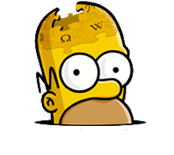
Bart the Genius/References
Contents
Production
The concept for the episode developed from writer Jon Vitti coming up with a long list of bad things Bart could do and imagining the potential consequences. The only idea that developed into an interesting episode concept was Bart cheating on an IQ test.[1] This idea was based on an incident from Vitti's childhood when a number of his classmates did not take an intelligence test seriously and suffered poor academic treatment because of it. Because Bart was already obviously unintelligent, Vitti reversed the problem for his episode.[2] Vitti used all his memories of elementary school behavior to produce a draft script of 71 pages, substantially above the required length of about 45 pages. It was Vitti's first script for a 30-minute television program.[1] Bart's use of the phrase "Eat my shorts" was intended to reflect his adoption of catchphrases he had heard on TV; the creative team had told Vitti that he should not come up with original taglines for the character.[1] The scene where the family plays Scrabble was inspired by the 1985 cartoon The Big Snit.[3]
The episode was the first to feature the series' full title sequence, including the chalkboard gag and couch gag. Matt Groening developed the lengthy sequence in order to cut down on the animation necessary for each episode, but devised the two gags as compensation for the repeated material each week.[3] Groening, who had not paid much attention to television since his own childhood, was unaware that title sequences of such length were uncommon by that time.[3] As the finished episodes became longer, the production team were reluctant to cut the stories in order to allow for the long title sequence, so shorter versions of it were developed.[4]
Director David Silverman had difficulty devising a legible Scrabble board for the opening scene that would get across the idea that the Simpsons had only been able to come up with very simple words.[4] The design of Bart's visualization of the math problem was partially inspired by the art of Saul Steinberg. The increasing appearance of numbers in that sequence derived from Silverman's use of a similar tactic when he had to develop a set design for the play The Adding Machine. Each successive scene in the sequence was shorter than the one before it by exactly one frame.[4] The scene where Bart writes his confession was done as one long take to balance the shorter scenes elsewhere in the episode. It was animated in the United States by Dan Haskett.[4] There were a few problems with the finished animation for the episode. The banana in the opening scene was colored incorrectly, as the Korean animators were unfamiliar with the fruit,[3] and the final bathtub scene was particularly problematic, including issues with lip sync. The version in the broadcast episode was the best of several attempts.[4] Martin Prince and Edna Krabappel make their first appearances in this episode.[5]
Reception and legacy
In a 1991 interview, Jon Vitti described "Bart the Genius" as his favorite among the episodes he had written to that point.[2] James L. Brooks mentioned the episode among his favorites, saying that "we did things with animation when that happened that just opened doors for us."[6] The show received mail from viewers complaining that the throwing away of a comic book was an incident of censorship.[3] In a DVD review of the first season David B. Grelck gave the episode a rating of 2.5/5, noting "it's easy to see with this episode why Bart became the figurehead for a few years of class clowns."[7] Warren Martyn and Adrian Wood, the authors of the book I Can't Believe It's a Bigger and Better Updated Unofficial Simpsons Guide, strongly praised the episode calling it "superbly written and directed, often a literal child's-eye view of education, the first Simpsons episode proper is a classic." They went on to say, "these twenty minutes cemented Bart's position as a cultural icon and a hero to all underachievers, and managed a good few kicks at hothouse schools along the way. Especially worthy of note is the sequence where Bart visualises his maths problem, the viewing of which should be a required part of teacher training."[5]
The invented word "Kwyjibo" inspired the creator of the Melissa worm.
Cultural references
- In the opening scene, Maggie spells EMCSQU with her blocks, a reference to Albert Einstein's mass-energy equivalence equation. A picture of Einstein also appears on the wall of Dr. Pryor's office. At one point Homer erroneously refers to Einstein as the inventor of the light bulb.
- Dr. Pryor compares Bart's proposed work among ordinary children to Jane Goodall's study of chimpanzees. Goodall was pleased to be mentioned in the episode, sending the program a letter, and Vitti a signed book. Jane Goodall was later featured as a major guest star in the episode "Simpson Safari".
- The composer of the opera the family attends is named Boris Csuposki, a reference to animator Gabor Csupo. The opera attended by the family is Carmen, by [[wikipedia:Georges Bizet|Georges Bizet]; the song Bart mocks is a famous aria called the Toreador Song.
- "Scrabble" The Simpsons are playing it in the beginning.
Trivia
General
- There is a picture of Bart on the wall opposite one of Albert Einstein in Dr. Pryor's office.
- After Bart comes home green Homer washes him in Turpentine.
- Homer thinks it was Albert Einstein that invented the light bulb.
- Maggie spells out EMCSQU (or E=MC²) on her building blocks.
- Maggie falls once (As Lisa looks up id).
Introductions
- Milhouse has black hair in this episode.
- This is the first episode where Bart uses his soon to be famous catch phrase "Eat My Shorts".
Hard to See Stuff
- Martin Prince is the train conductor when Bart is told to visualize his IQ problems.
- Principal Skinner devotes an entire file drawer to Bart Simpson.
- Homer makes a cheque of $75, to pay for Bart's defacing of school property, to "Dept. of Education".
- Martin's IQ is 216.
- Bart wears a pink shirt to his first day of class at the "Enriched Learning Center for Gifted Children".
- Books on the shelf in Bart's new advanced school classroom include Crime & Punishment, Babylonian Myths, Paradise Lost, Moby-Dick, Plato, Dante's Inferno, The Illiad, Plato, Design of Computers (remember this is 1990), Astrophysics, Wana by Emile Zona, Puskin, Shakespeare I-XV, Quantum Mechanics, and the Life of Leonardo.
- The Simpsons attend the opera "Carmen", advertised as "Tonight Only in Russian."
- On the opera poster, the conductor is identified as Boris Csuposki, a play on the name of producer and supervising animation director Gabor Csupo.
- After he is dubbed a genius, Bart's Principal Skinner graffiti is framed and labeled as a work of art entitled "The Principal" by Bart Simpson.
- Martin and his parents were at the opera.
- ↑ 1.0 1.1 1.2 Vitti, Jon. (2001). The Simpsons The Complete First Season DVD commentary for the episode "Bart the Genius" [DVD]. 20th Century Fox.
- ↑ 2.0 2.1 Jankiewicz, Pat. "Jon Vitti." Comic Scene #17, February 1991.
- ↑ 3.0 3.1 3.2 3.3 3.4 Groening, Matt. (2001). The Simpsons The Complete First Season DVD commentary for the episode "Bart the Genius" [DVD]. 20th Century Fox.
- ↑ 4.0 4.1 4.2 4.3 4.4 Silverman, David. (2001). The Simpsons The Complete First Season DVD commentary for the episode "Bart the Genius" [DVD]. 20th Century Fox.
- ↑ 5.0 5.1 Martyn, Warren; Wood, Adrian (2000). Bart the Genius. BBC. Retrieved on 2007-08-05.
- ↑ Braun, Kyle. The Simpsons Movie Interviews. Ugo.com. Retrieved on August 5, 2007.
- ↑ Grelck, David B. (2001-09-25). The Complete First Season. WDBGProductions. Retrieved on 2007-05-07.
